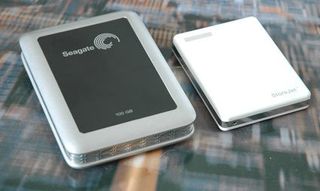Small or Smaller? Ultraportable Hard Disks
1.8" Or 2.5" Ultraportable Drives From Seagate And Transcend

There are lots of potentially interesting drives available today. We picked the Seagate model to represent the 2.5" side because it has one of the largest capacities around. Transcend was our 1.8" choice thanks to its neat design. We included the benchmark results from several preceding hard drive reviews, so you can compare both drives' performance with common models from Coolmax, LaCie, Maxtor, Seagate, Waitec, WiebeTech and others.
It's interesting to observe that many vendors continue to chase RAM-like applications for their drives, despite ever-increasing hard disk sizes. The reason is simple: more data is in use, so more storage is needed to accommodate it. Hard disks in desktop PCs are mostly big enough to meet users' needs, but despite ample amounts of this fixed storage, a workable solution for transporting large amounts of data has yet to emerge.
Today, storing digital data permanently on hard disks is no longer enough for most users. We want more content available for all kinds of applications, and we want to take it with us wherever we might go. It's indisputable that DSL and other types of broadband have made the Internet faster and given everyone access to tremendous amounts of data wherever they go. But this has just underscored the fact that multi-gigabyte data repositories can't move around anywhere near as easily as their users can.
USB flash memory devices ("pen drives" or "memory sticks") remain the most convenient of all data transport media. You can find them in capacities of up to 8 GB, but as capacity increases beyond 1 GB, costs become excessive. Still, a USB port is usually the best way to access portable data collections.
Writable DVD is another option, since data stored on DVD is safe from harm or loss due to disk crashes or corruption, assuming that the plastic disk is handled with proper care. But not every PC has a DVD drive - either because it is too old, or because the drive was omitted to save weight on ultralight notebooks - so an alternative remains necessary.
Classic 3.5" external drives are overkill for many people. While they're both big and flexible, they're not well-suited for ongoing mobile applications. Who wants to add a two-pound bag with an external drive - and cables and power supply - to what they must already carry around?
Smaller hard disks have the potential to provide a solution that addresses the limitations of the preceding storage methods, by pairing the capacity and convenience of a hard disk with greater portability. Recently, Seagate sent us a 100 GB 2.5" hard disk built into a slick enclosure; we also received an even smaller device from Transcend that offers 20 or 40 GB of storage. Given these choices, which approach makes the most sense?
Stay On the Cutting Edge: Get the Tom's Hardware Newsletter
Join the experts who read Tom's Hardware for the inside track on enthusiast PC tech news — and have for over 25 years. We'll send breaking news and in-depth reviews of CPUs, GPUs, AI, maker hardware and more straight to your inbox.
Current page: 1.8" Or 2.5" Ultraportable Drives From Seagate And Transcend
Next Page Seagate 100 GB Portable External Hard Drive
Microsoft is switching RAM speed units in Task Manager — finally moving to the more technically correct MT/s

Pre-Memorial Day Sales 2024: Save on gaming laptops, CPUs, monitors and more

Lenovo ThinkPad P1 Gen 7 is the world's first laptop to sport LPCAMM2 memory — more compact, higher performance, lower power
Most Popular



